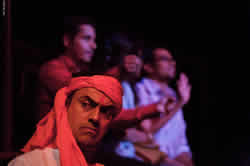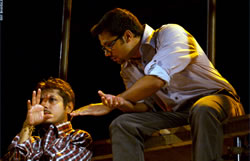Me, Kash & Cruise – A Competent and Cleverly Crafted Production of Significance
A Review by Manohar Khushalani


(Left) Rajit Kapoor as many faces of “Bombay” (Right) Amit Mistry & Neil Bhoopalam
As a finale to his earlier plays: Class of 84 and Pune Highway, Matrix Presented Rahul Da Cunha’s last one of the trilogy, Me, Kash and Cruise at India HabitatCenter. For me personally it was a watershed of memories. The play opens with a backdrop of 1984 Bombay Riots. It was in 1984 when our street theatre group,Theatre Union, disembarked at Mumbai’s Churchgate Station to participate in the Natya Jatra, a festival of Street plays performed by Theatre Workers and activists from all over India. It was at the railway platform itself that we learnt that Indira Gandhi had been assassinated by her Sikh Bodyguards. We arrived at Rabindra Rangshala, the venue of performance to learn that all the shows had been cancelled. Not to be deterred we proceeded to Flora Fountain for our first impromptu performance. Despite the tragedy my sense of humour about the irony of the situation had not abated as I showered my jokes on my hapless colleagues in the local train to the venue of the show. Apparently a pick pocket was not amused or maybe he decided to have the last laugh as he slickly dispossessed me of my purse, which contained all my finances. But the show must go on and perform we did to an appreciative audience.
In the next ten days we were all stuck at Rabindra Rangshala as the trains were not moving and all the theatre groups performed for each other. Just as a singer is requested for an encore, our rendition of Sadat Hasan Manto’s Toba Tek Singh was most popular, and we performed it repeatedly for other groups. No. One is not going on a tangent. I am coming to the point.
Amongst the performers was a troupe led by Gursharan Singh, A famous Sikh playwright director from Punjab who performed courageously against militancy inPunjab. Throughout our incarceration we continued to hear all kinds of rumoursabout how Sikhs were being butchered in the communal riots in Delhi. There were also rumours about protection money given by them to the Underworld for remaining safe in Mumbai. One had also heard about how Shiv Sena in Mumbai and RSS inDelhi had offered protection to the Sikhs. In an environment of fear and fervour – with and without veracity – roumours abounded. It is this atmosphere that Rahul Da Cunha’s play captured with authenticity, that one can vouch for, from personal experience.
Set in Bombay, the play covers a twenty four year time horizon – 1984 to 2008.Bombay has been a city that encompasses every emotion – from nostalgia to frustration. And joy to fear. Me, Kash and Cruise is the roller coaster story of three Bombayites and their attempts to deal with the city’s ever changing social, civic and political landscape – with mostly hilarious, and sometimes tragic consequences. The play opens with the death of Indira Gandhi, while the three protagonists – Pooja Thomas (unabashed Bombay lover), Rajesh Kashyap (true blue South Bombayite) and Cruise (A Delhiite, and named after the Hollywood star) traverse their way through the 1992 riots, the 1993 bomb blasts, the Moral Police and Bollywood mania, as well as the age of marketing and hype – among other dramatic events that have shaken and influenced our city. Including man made disasters such as dug up roads and festival band baaja. And of course, Himmesh Reshammiya !!
Da Cunah’s assembled and portable set design is a labyrinth of multi level cat walks with interconnecting stairs – almost a reflection of the intertwining relationships of the three main characters torn apart by their own complexities and yet thrown together by circumstances and similar interests – primarily theatre, Pooja Thomas and Rajesh Kashyap are well grounded bombayites. Cruise a typical “struggler’ from Delhi 6 – the place in Delhi which has contributed maximum actors to Delhi Theatre. Since Cruise is trying to ‘make it’ while the other two are established in the city there is bound to be a difference in their priorities. While Pooja is attracted by; the entrepreneur spirit of Cruise, Kashyap disapproves of his lack of commitment to theatre. Da Cunah script comes to terms with these realities in an objective manner. He also sketches out how their relationships and lives change with the external influences of the traumatic political events that rock the city. How people cannot remain unaffected islands and how the social upheavals suck people into their vortex. The director is very original in the way the blocking has been done. People can be interacting with each other directly, but from different levels. Even the classic ‘asides’ can be belted out from different spaces. The division of the stage is not the typical horizontally segmented ‘upstage’ and ‘downstage’ but more literally – vertically – up down and middle levels.
The performances of the three actors Yamini Namjoshi, Amit Mistry and Neil Bhoopalam are fluid and flawless. The well known actor Rajit Kapoor does many roles of the other characters. He is the fourth character, mysteriously namedBOMBAY winds away though the play, donning many guises and avatars – Gateway photographer, police havaldar, marketing executive etc.
Cast : Yamini Namjoshi, Amit Mistry, Neil Bhoopalam and Rajit Kapur
Written & Directed by Rahul da Cunha
A Rage Production
Sponsor Matrix


